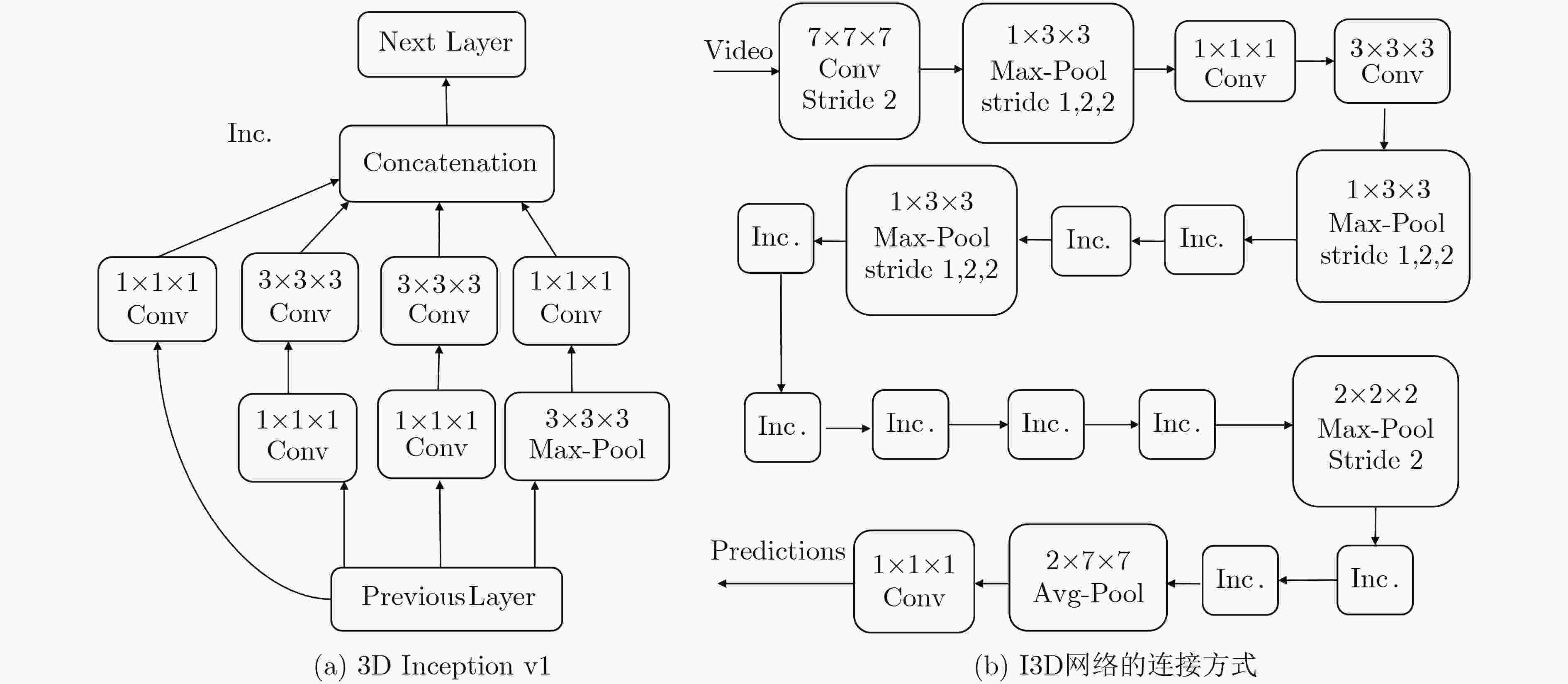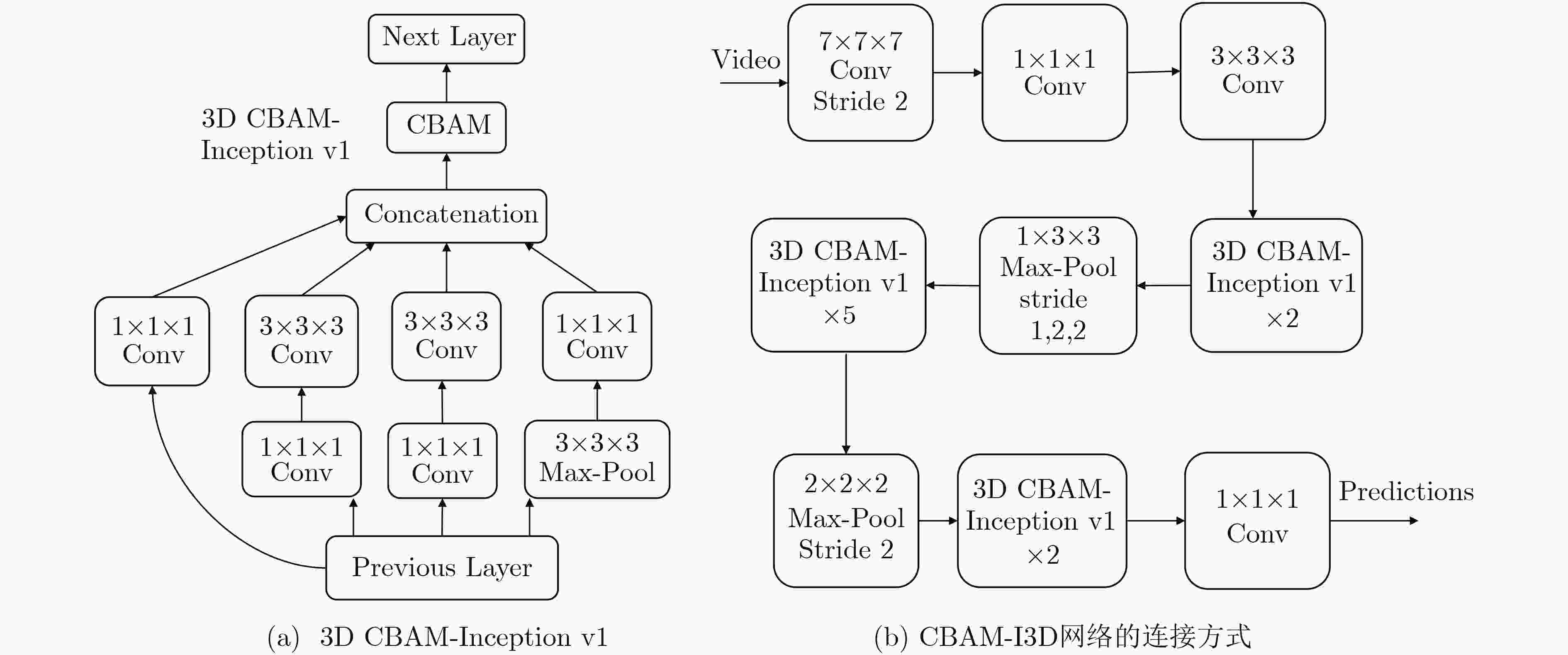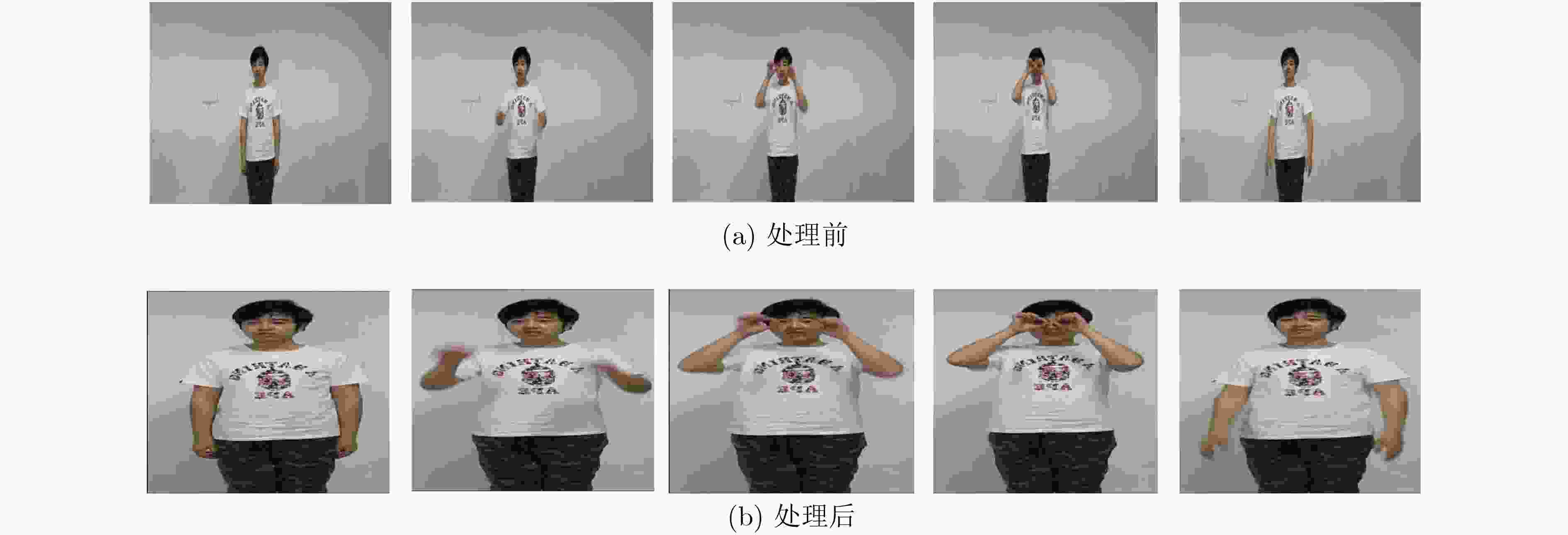Dynamic Gesture Recognition Combining Two-stream 3D Convolution with Attention Mechanisms
-
摘要: 得益于计算机硬件以及计算能力的进步,自然、简单的动态手势识别在人机交互方面备受关注。针对人机交互中对动态手势识别准确率的要求,该文提出一种融合双流3维卷积神经网络(I3D)和注意力机制(CBAM)的动态手势识别方法CBAM-I3D。并且改进了I3D网络模型的相关参数和结构,为了提高模型的收敛速度和稳定性,使用了批量归一化(BN)技术优化网络,使优化后网络的训练时间缩短。同时与多种双流3D卷积方法在开源中国手语数据集(CSL)上进行了实验对比,实验结果表明,该文所提方法能很好地识别动态手势,识别率达到了90.76%,高于其他动态手势识别方法,验证了所提方法的有效性和可行性。
-
关键词:
- 动态手势识别 /
- 深度学习 /
- 双流3维卷积神经网络 /
- 注意力机制 /
- BN层
Abstract: Benefits from the progress of computer hardware and computing power, natural and simple dynamic gesture recognition gets a lot of attention in human-computer interaction. In view of the requirement of the accuracy of dynamic gesture recognition in human-computer interaction, a method of dynamic gesture recognition that combines Two-stream Inflated 3D (I3D) Convolution Neural Network (CNN) with the Convolutional Block Attention Module (CBAM-I3D) is proposed. In addition, relevant parameters and structures of the I3D network model are improved. In order to improve the convergence speed and stability of the model, the Batch Normalization (BN) technology is used to optimize the network, which shortens the training time of the optimized network. At the same time, experimental comparisons with various Two-stream 3D convolution methods on the open source Chinese Sign Language (CSL) recognition dataset are performed. The experimental results show that the proposed method can recognize dynamic gestures well, and the recognition rate reaches 90.76%, which is higher than other dynamic gesture recognition methods. The validity and feasibility of the proposed method are verified. -
表 1 本文方法与其他方法在CSL数据集上的实验结果对比
网络结构 Top1准确率(%) 网络训练时间(h) 平均检测时间(s) C3D(RGB) 70.53 35.15 2.05 CBAM-C3D(RGB) 71.77 36.26 2.10 C3D(RGB+Optical) 71.28 75.45 3.39 CBAM-C3D(RGB+Optical) 72.86 76.15 4.01 MFnet(RGB) 73.61 12.14 0.15 CABM-MFnet(RGB) 74.25 13.28 0.17 MFnet(RGB+Optical) 74.65 29.20 0.28 CABM-MFnet(RGB+Optical) 76.19 30.08 0.31 3D-ResNet(RGB) 79.52 24.42 0.58 CBAM-3D-ResNet(RGB) 82.90 25.43 0.61 3D-ResNet(RGB+Optical) 83.96 55.15 1.02 CBAM-3D-ResNet(RGB+Optical) 85.28 56.20 1.08 I3D(RGB) 84.56 20.29 0.41 CBAM-I3D(RGB) 86.00 21.31 0.42 I3D(RGB+Optical) 88.18 46.52 0.75 CBAM-I3D(RGB+Optical) 90.76 47.28 0.81 -
[1] TAKAHASHI T and KISHINO F. A hand gesture recognition method and its application[J]. Systems and Computers in Japan, 1992, 23(3): 38–48. doi: 10.1002/scj.4690230304 [2] BANSAL B. Gesture recognition: A survey[J]. International Journal of Computer Applications, 2016, 139(2): 8–10. doi: 10.5120/ijca2016909103 [3] 张淑军, 张群, 李辉. 基于深度学习的手语识别综述[J]. 电子与信息学报, 2020, 42(4): 1021–1032. doi: 10.11999/JEIT190416ZHANG Shujun, ZHANG Qun, and LI Hui. Review of sign language recognition based on deep learning[J]. Journal of Electronics &Information Technology, 2020, 42(4): 1021–1032. doi: 10.11999/JEIT190416 [4] PARCHETA Z and MARTÍNEZ-HINAREJOS C D. Sign language gesture recognition using hmm[C]. The 8th Iberian Conference on Pattern Recognition and Image Analysis, Faro, Portugal, 2017: 419–426. doi: 10.1007/978-3-319-58838-4_46. [5] PU Junfu, ZHOU Wengang, ZHANG Jihai, et al. Sign language recognition based on trajectory modeling with HMMs[C]. The 22nd International Conference on Multimedia Modeling, Miami, USA, 2016: 686–697. doi: 10.1007/978-3-319-27671-7_58. [6] SAMANTA O, ROY A, PARUI S K, et al. An HMM framework based on spherical-linear features for online cursive handwriting recognition[J]. Information Sciences, 2018, 441: 133–151. doi: 10.1016/j.ins.2018.02.004 [7] MASOOD S, SRIVASTAVA A, THUWAL H C, et al. Real-time sign language gesture (word) recognition from video sequences using CNN and RNN[M]. BHATEJA V, COELLO C A C, SATAPATHY S C, et al. Intelligent Engineering Informatics. Singapore: Springer, 2018: 623–632. doi: 10.1007/978-981-10-7566-7_63. [8] DONAHUE J, JIA Yangqing, VINYALS O, et al. DeCAF: A deep convolutional activation feature for generic visual recognition[C]. The 31st International Conference on International Conference on Machine Learning, Beijing, China, 2014: I-647–I-655. [9] TRAN D, BOURDEV L, FERGUS R, et al. Learning spatiotemporal features with 3d convolutional networks[C]. 2015 IEEE International Conference on Computer Vision, Santiago, Chile, 2015: 4489–4497. doi: 10.1109/ICCV.2015.510. [10] CHEN Yunpeng, KALANTIDIS Y, LI Jianshu, et al. Multi-fiber networks for video recognition[C]. The 15th European Conference on Computer Vision, Munich, Germany, 2018: 364–380. [11] HE Kaiming, ZHANG Xiangyu, REN Shaoqing, et al. Deep residual learning for image recognition[C]. 2016 IEEE Conference on Computer Vision and Pattern Recognition, Las Vegas, USA, 2016: 770–778. doi: 10.1109/CVPR.2016.90. [12] HUANG Jie, ZHOU Wengang, LI Houqiang, et al. Sign language recognition using 3D convolutional neural networks[C]. 2015 IEEE International Conference on Multimedia and Expo (ICME), Turin, Italy, 2015: 1–6. doi: 10.1109/ICME.2015.7177428. [13] SIMONYAN K and ZISSERMAN A. Two-stream convolutional networks for action recognition in videos[C]. The 27th International Conference on Neural Information Processing Systems, Montreal, Canada, 2014: 568–576. [14] BAKER S, SCHARSTEIN D, LEWIS J P, et al. A database and evaluation methodology for optical flow[J]. International Journal of Computer Vision, 2011, 92(1): 1–31. doi: 10.1007/s11263-010-0390-2 [15] CAO Zhe, SIMON T, WEI S E, et al. Realtime multi-person 2D pose estimation using part affinity fields[C]. 2017 IEEE Conference on Computer Vision and Pattern Recognition, Honolulu, USA, 2017: 1302–1310. doi: 10.1109/CVPR.2017.143. [16] CARREIRA J and ZISSERMAN A. Quo Vadis, action recognition? A new model and the kinetics dataset[C]. 2017 IEEE Conference on Computer Vision and Pattern Recognition, Honolulu, USA, 2017: 4724–4733. doi: 10.1109/CVPR.2017.502. [17] WOO S, PARK J, LEE J Y, et al. CBAM: Convolutional block attention module[C]. The 15th European Conference on Computer Vision, Munich, Germany, 2018: 3–19. [18] HUANG Jie, ZHOU Wengang, ZHANG Qilin, et al. Video-based sign language recognition without temporal segmentation[C]. The 32nd AAAI Conference on Artificial Intelligence, (AAAI-18), the 30th innovative Applications of Artificial Intelligence (IAAI-18), and the 8th AAAI Symposium on Educational Advances in Artificial Intelligence (EAAI-18), New Orleans, USA, 2018: 2257–2264. [19] HU Jie, SHEN Li, and SUN Gang. Squeeze-and-excitation networks[C]. 2018 IEEE/CVF Conference on Computer Vision and Pattern Recognition, Salt Lake City, USA, 2018: 2011–2023. doi: 10.1109/CVPR.2018.00745. [20] IOFFE S and SZEGEDY C. Batch normalization: Accelerating deep network training by reducing internal covariate shift[C]. The 32nd International Conference on Machine Learning, Lille, France, 2015: 448–456. [21] 刘天亮, 谯庆伟, 万俊伟, 等. 融合空间-时间双网络流和视觉注意的人体行为识别[J]. 电子与信息学报, 2018, 40(10): 2395–2401. doi: 10.11999/JEIT171116LIU Tianliang, QIAO Qingwei, WAN Junwei, et al. Human action recognition via spatio-temporal dual network flow and visual attention fusion[J]. Journal of Electronics &Information Technology, 2018, 40(10): 2395–2401. doi: 10.11999/JEIT171116 -






 下载:
下载:






 下载:
下载:
